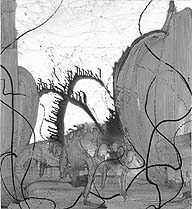|
ARTFORUM DECEMBER 2000 pp. 147-148 JONATHAN FELDSCHUHCYNTHIA BROAN GALLERY In "Little Corner of the World," his first solo show in New York, Jonathan Feldschuh exhibited twelve canvases, varying in size but consistent in their mixture of cartoonish sci-fi and romantic verve. A product of the Harvard physics department, Feldschuh has a nice feel for the fine line between microscopic and cosmic conceptions of space and good instincts for the salutary effect of elegance on silliness (and vice versa). Feldschuh alternates layers of acrylic paint with thick coats of clear medium, so that the final image reads as a series of laminated tissues, each one at once obscuring and revealing those lying beneath. Tightly drawn, faintly figurative elements—root systems or ganglia? Robotic pods?—hover near the picture plane, seeming to float on the outer stratum of loose color washes and glassy medium. Feldschuh softens the forms here and there by sanding the layers of dried acrylic(the canvases are stretched over panels to support this punishment). The result is reminiscent of a digital screen, with its crystalline false space, or of superimposed transparent pages in a medical textbook. Such direct play of flatness and depth runs the risk of metaphorical portentiousness, suggesting self-conscious comment about painting as a historical phenomenon—the materiality of the allover abstract surface pitted against the illusion of animated pixellation and baroque fantasy. But this particular version of art's pitched battle got funnier as it became more literal. Feldschuh doesn't mind showing us that he is working on very basic problems posed by paint, like how to make it lie down on or jump out from a canvas—and in these innocent inquiries, he seems to be having a really good time. The paintings are both un-apologetically goofy and unapologetically pretty. Color is laid down as if the artist were constantly consulting a painter's encyclopedia of possible gestures: Virile AbEx spatters and comic-book explosions interweave with elegant, calligraphic lines like those of Brice Marden; Feldschuh's nervously articulated biomechanical forms, meanwhile, owe something to Inka Essenhigh or Alex Ross. In spite of the shallow, plasticky feel imparted by the acrylic laminations, the paintings remain preoccupied with landscape, always returning to the fundamental organizing principles of foreground, middle ground, and background. There are passages suggestive of Hudson River School sunsets and cloudy blobs a la Tiepolo. A style so heavily dependent on pastiche runs the risk of a cute soullessness. There is a forced quality in Feldschuh's titles—A Wonderful Buy in a Wraparound Sky; As Though to Breathe Were Life—that suggests he may be trying to do too many things at once, attempting to force more meaning into the paintings than they intrinsically warrant. The key to "Little Corner of the World" lay in its exuberant physicality. Like a twelve-year-old boy who draws the same muscled superhero over and over, Feldschuh uses his sinewy doodles to express the power of mark-making. He knows such power is nonsen-sical, and also that nonsense has a sublime edge. But such fun won't last without continually challenging itself. For the paintings to deepen, Feldschuh might ask himself a question rarely posed in comics (or philosophy): What happens when a superhero evolves? When vitality and absurdity pursue their dialectic, what forms emerge? -Frances Richard
|
Jonathan Feldschuh, Spirulina, 2000, acrylic on canvas over panel, 78½ x 72½" |
|
Read all available reviews: |
|
